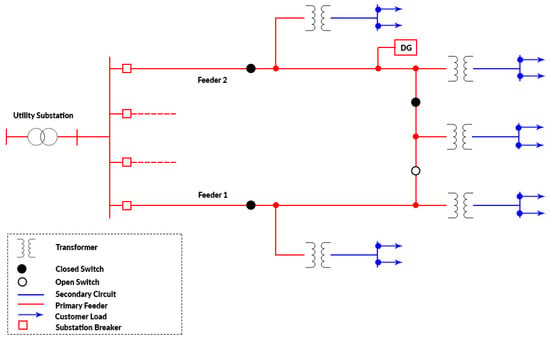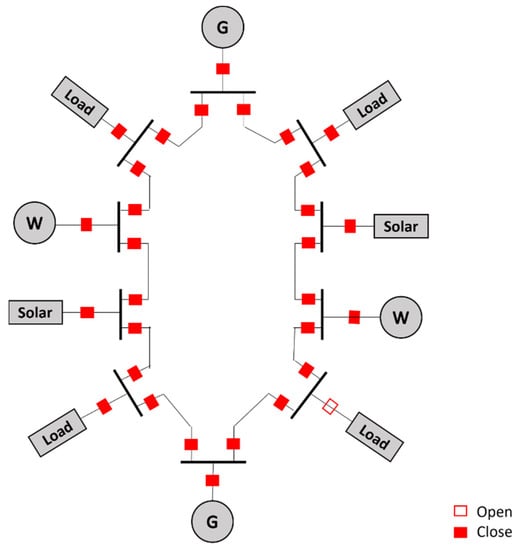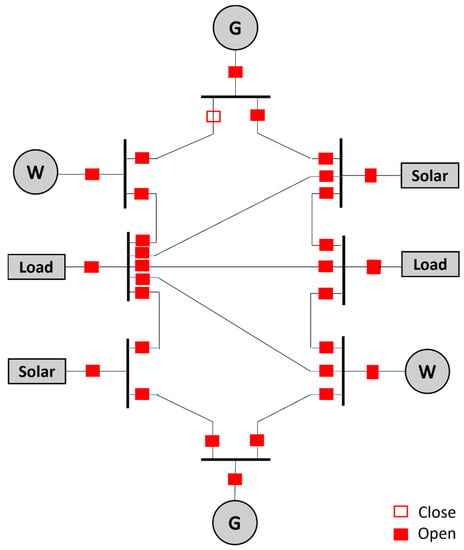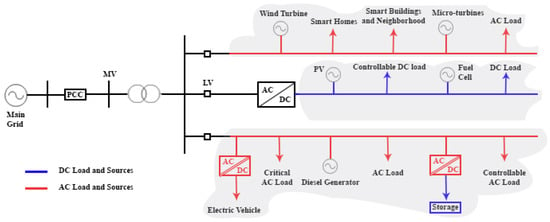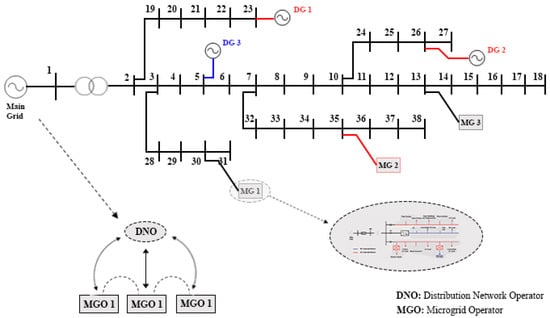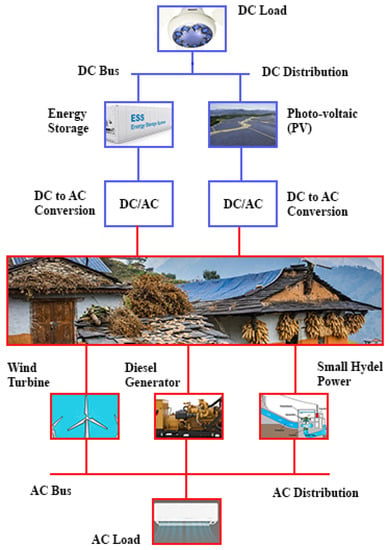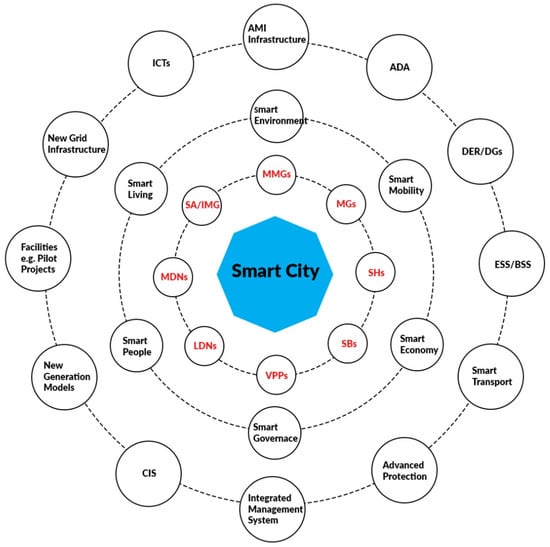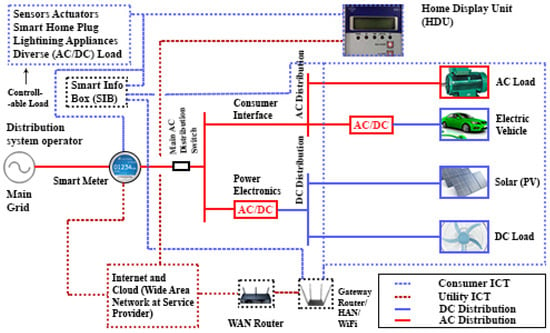1. Active Radial Distribution Networks
When DGs are connected to a passive distribution network, the network is termed an active distribution network. In RDN, DGs efficiently minimize actual power losses and increase the voltage profile [
27]. The ARDN concept is fundamentally a variant of RDN reconfiguration, allowing for more precise DG deployment and loss reduction. The inclusion of normally open switches (NOS) ensures the radial operation of DN [
28]. To transfer loads across a community of interconnected radial feeders while maintaining synchronized power flow, the reconfiguration is accomplished by adjusting the open/closed status of tie/sectionalizing switches [
29]. An abrupt increase in demand and capability deficiency of T&D facilities are the prime concerns, which ensure a rapid growth in deployment of DGs at distribution level [
30]. As a result, ARDN encourages more precise deployment of DG units and offers many benefits, such as loss reduction and enhanced voltage profile. In respect of voltage sags and electricity supply problems, this precise DG placement feature improve the system’s stability and power quality issues. The schematic diagram for ARDN is shown in
Figure 7.
Figure 7. Active radial distribution network.
2. Ring or Loop Distribution Networks
The loop distribution network (LDN) is a more modern variant of the traditional distribution network (DN) under the umbrella of advanced power distribution mechanism (APDS) applications in which main feeders operate in a loop structure [
31]. In LDN topology the utility can deliver power in any direction of the loop [
32]. Higher reliability, improved stability index, fault isolation and large DG penetration features make the LDN topology more preferrable over conventional RDN topology [
31]. The schematic view of LDN is shown in
Figure 8. The advantages of looping the traditional RDN by a series of electronic devices to monitor power flow were explored by the authors in [
33]. In [
34], the authors proposed a load transfer model (LTM) to investigate the effectiveness of transition to closed loop distribution network (CLDN). However, as opposed to conventional planning approaches, LDNs typically have higher informing cost limits, enhanced protection needs, sophisticated automation, anticipated increases in short-circuit currents, dynamic monitoring needs, and comparatively high losses. Costs and losses are two main constraints that restrict further research and development on LDN and encourage the adoption of RDN configuration at operation level. However, some entities, such as the Singapore Power Company, Taiwan Power Company, Hong Kong Electrical Supply Company, and others, continue to provide high-reliability service to their customers using LDNs. Need-based loops and ordinarily closed loops are two different operating topologies in LDN. Close a select number of tie switches to convert a component or a set of tie switches to convert the whole mechanism into a loop to accomplish either mode.
Figure 8. Loop distribution network: a conceptual diagram (adapted from [
35]).
3. Meshed Distribution Networks
The meshed distribution network (MDN) is considered a variant of LDN, generally referred as a multiloop distribution network (MLDN). It is normally exposed to the same problems and, for the most part, the same specifications as LDN. The schematic illustration of MDN is shown in
Figure 9. While a meshed network can be an economically suitable alternative, it does necessitate modifying the protection approaches, which is incompatible with a meshed operation. In comparison to LDN, it has the benefits of higher stability, large DG infiltration, better voltage response, and relatively lower power losses [
34]. Comparably with RDNs, primary MDNs offer benefits such as lower short circuit current, shorter overall conductor length, and increased reliability and fault tolerance [
36]. However, the practical implementation of MDN is not common globally due to its complex installation and coordination of relays during protection. Standard planning techniques, on the other hand, are more vulnerable to failures and early recovery due to dynamic fault traceability [
37]. For standard protection purposes, based on fault current limiter devices, the NOS could be replaced by “quick deloopers” that can bring the system back to radial configuration for stable operation in cases of abnormal conditions [
28]. In MDN, the most common configurations are weakly meshed and completely meshed DN [
38,
39].
Figure 9. Meshed distribution network: a conceptual diagram (adapted from [
35]).
4. Microgrids
Microgrids (MG), a subset of the SG concept and regarded as the building blocks of it, are possibly the most promising and innovative network structure for ensuring a reliable, cost-effective, and environment-friendly energy solution for a community. MGs allow and encourage a large penetration of DGs, such as microturbines, fuel cells, and PV arrays, as well as ESS, such as flywheels, supercapacitors, and adjustable loads, at the distribution level, which provide control capabilities over network operation.
Figure 10 depicts the fundamental structure of MGs that contain both AC and DC topology. The main advantages and vital role of MGs is their operation in both grid-connected and stand-alone mode. These control skills enable DNs, which are often tied to the upstream DN, to operate when disconnected from the main grid in the event of faults or other external disruptions or catastrophes, therefore improving supply quality [
7].
Figure 10. Microgrid: a conceptual and graphical overview and framework.
According to a European research project [
7], “MGs are LV distribution systems that incorporate DERs (microturbines, fuel cells, PV, and so on) as well as storage devices (flywheels, energy capacitors, and batteries) and flexible loads. If linked to the grid, such systems can function in a non-autonomous mode, or in an autonomous mode if detached from the main grid. When controlled and coordinated properly, the functioning of micro-sources in the network can bring significant improvements to overall system performance.” According to [
40], “MG concept implies a cluster of loads and micro-sources that operate as a single controlled system that delivers both electricity and heat to its immediate surroundings.” According to the US Department of Energy (DOE) [
41], “the term ‘MG’ refers to a group of associated loads and DERs with well-defined electrical boundaries that behave as a single controlled entity with regard to grid and may connect and detach from utility grid to operate in both grid-connected and stand-alone modes.”
From distribution perspectives, MGs are classified into three types i.e., AC, DC, and hybrid [
42]. In AC-MGs, all RESs and loads are linked to a shared AC bus, while DC-MGs can be operated in grid-connected or stand-alone mode. All the DC loads are connected directly with a DC bus. Where the hybrid MG is connected to utility grid through a static transfer switch (STS) or point of common coupling (PCC). The power electronic interface controls the power flow between the networks and the utility grid. The power direction is determined by the balance of load and generation.
5. Multi-Microgrids
According to IEEE Std 1547.4, a large DN can be modified to clustered MGs called MMGs to facilitate the control and operation (C&O) infrastructure in future DN [
43]. With the MGs’ large-scale interconnection to the electricity grid, an MMG architecture will emerge from a group of nearby MGs in each region.
Figure 11 depicts MMG architecture, which provides new approaches to deal with the challenges of planning and facilitate the control and operation infrastructure in future distribution scenarios while achieving certain goals, such as power quality, reliability, and DG siting and scaling.
MMGs offer an efficient P2P energy trading and information sharing facility between different MGs to achieve cost-reliable and efficient solutions of electricity delivery to end customers. This improves the economical operation for all stakeholders. When the permeability of MGs improves, it becomes more difficult to coordinate the efficient and dependable functioning of various sub-MGs. MMGs are classified into three constitutional frameworks: AC, DC, and hybrid. All the microsources in AC-MMGs are connected to AC buses via converters. Microsources are connected to DC buses in DC-MMGs via converters, which are typically loaded with DC loads, and the DC-MMGs are connected to the external power grid via inverters [
44]. Remote places with limited access to utility grid electricity, family communities, business buildings, industrial parks, and experimental research are some of the main application possibilities for MMGs.
Figure 11. Multimicrogrid: a conceptual and graphical overview (adapted from [
45]).
6. Virtual Power Plants
Virtual power plants (VPPs) have emerged as a potential option for flexible energy management in ADNs, with the rising penetration of DERs such as RESs, battery storage, and controlled loads [
46]. Different authors treat the definition of virtual power plants (VPPs) in different ways in the literature. For example, [
47] defined the VPP as an autonomous MG. A VPP, according to the FENIX project concept, is the aggregation of many heterogeneous DERs with varying capacities, which generates a single operational profile from a composite of the attributes describing each DERs and can integrate the network’s influence on aggregate DER output for the purpose of enhancing reliability, power generation, and trading or selling of power on the electricity market [
48,
49]. Fundamentally, the VPP concept is comparable to the MMG approach, which is controlled and managed by a central body and consists of a variety of DERs with responsive loads dispersed throughout vast geographic areas [
12]. The main difference between MGs and VPPs is that MGs can be either grid-connected or stand-alone, while VPPs will always operate in grid-connected mode. On the basis of operational and technical constraints, VPPs are divided into two major classes in the literature, i.e., commercial (focusing solely on the economic aspect, with no requirement for geographic closeness of aggregated sources) and technical (in contrast to the commercial VPP, aggregated resources are physically close together, and their coordinated control takes into account electrical network constraints) [
50].
Figure 12 shows the conceptual framework for VPP.
Figure 12. Conceptual framework of virtual power plant setup (adapted from [
18,
51]).
7. Smart Homes
Smart home (SH) service is an essential component of smart grid usage. It is a real-time interactive response between the power grid and users that improves the power grid’s comprehensive service capability while also realizing intelligent and interactive electricity use. It also improves the power grid’s operation mode and users’ consumption patterns to improve end users’ energy efficiency [
52]. The SH concept can be defined from many different perspectives. Different authors define SHs differently, but the conceptual identification of SHs from all studies’ point of view remains the same. According to [
53], the concept of SHs is defined as “SH is a pervasive computing application in which the home environment is supervised by ambient intelligence in order to deliver context-aware services and enable remote home management.” SHs, according to [
54], are residences equipped with computing and information technology that foresees and responds to the needs of the residents, employed to indorse their ease, expediency, security, and entertainment through the management of technology within the home and influences on the outside world. According to another definition, “SH is a residential-based platform that connects various facilities through the network to meet the system’s automation requirements and provide more convenient control and management. It makes use of internet of things (IoT), computer, control, image display, and communication technology [
52].” As a concept, SHs have significant appeal in the present and future SG domains due to their ability to optimize power usage based on electricity consumption and production capacity. Internal network, intelligent control, and home automation are the key enablers of SHs. Services offered by SHs include comfort, remote access, home automation, repository, energy optimization, and health care. SHs demand specialties from different background, e.g., communications engineers, computer and software engineers, and thermal engineering specialists. However, power and energy specialists are vital in designing and optimizing the framework of SHs, so a lot of research has been carried out in the last few years in the field of power and energy.
From a power and energy specialists’ viewpoint, the research carried out in the last few years in planning, operation, and control aspects of SHs is discussed below. The Figure 13 shows a conceptual framework for SHs.
Figure 13. Smart homes: a conceptual framework (adapted from [
18,
55]).
8. Smart Neighborhoods
Buildings may be a huge source of flexibility when it comes to dealing with the SG’s problems. A cluster of buildings or a neighborhood, in particular, can provide more flexibility by adjusting their energy profile. The interactions between buildings and the SG in a neighborhood have the potential to assist in controlling energy consumption in the SG environment. These interactions between SG and SNH may be achieved using the MAS paradigm, with the SNH acting as an MG. SBs and their related controls in a neighborhood are capable of reacting to DR requests from system operators to manage peak demand in order to minimize demand charges or to alter operations depending on real-time market prices of electricity. At whatever level, the operation of a SNH has two primary goals: to maximize energy flexibility and to maximize user comfort [
56]. SNHs [
57] are high-performance homes constructed with increased energy-efficiency features that exceed industry requirements. Features of SNH homes include energy efficiency, interaction between appliances, novel security and privacy solutions and home automation. The concepts of SNHs is shown in
Figure 14.
Figure 14. Smart neighborhoods: a conceptual framework.
Standard features of SNH include programmable thermostats, better insulation, high-efficiency heat pumps, and water heaters and appliances. SNH homes are designed based on the homeowner’s demands and mindset. They are outfitted with smart technologies and give a suitable network to assist in managing and controlling various parts of the home.
9. Smart Buildings
The concept of SBs originated in the early 1980s. In a 1984
New York Times story, real estate developers were characterized as constructing “a new generation of buildings that virtually think for their own, termed intelligent buildings.” Such types of intelligent buildings were a combination of old structure building management and telecommunication technologies [
58]. SBs are a structure that automatically controls the different operations of buildings, including HVAC systems, lightning, and security. The topic of SBs is inextricably related to the smart grid concept. SBs rely on a collection of technologies to improve energy efficiency, user comfort, and facility monitoring and security. SBs by definition can combine building management needs with IT technologies to enhance system efficiency, at the same time simplifying typical service functions. IoT-based technologies are the key drivers used in building management systems (BMSs) and monitor HVAC systems snd software packages for automatically switching off/on the different appliances [
58].
In the context of the smart grid concept, the following features are the key enablers of SBs [
59], shown in
Figure 15.
Figure 15. Smart buildings: key features, enablers, and conceptual framework.
Renewable Energy Resources: SBs consist of RESs (mostly PV systems) installed on the roof, parking, or ground of the building along with BES system. These RESs operate in such a way that during peak time slots when energy prices are high, a building operates only on solar-based system. During low demand and low energy price hours, the building takes electricity from the utility to meet its demand, while the PV system charges the battery bank for upcoming peak hours. RESs may be coordinated via smart meters to offer optimal energy flow to balance out the system’s frequency level. Net metering allows energy to be sold to the grid or utilized by the building.
Energy Storage: Electric storage systems provide backup during peak demand. Battery backup gets charged during off-peak time slots through RESs and discharged during peak time slots. Battery backup systems could be either BESs or EVs (V2G concept). EVs can act as ESS. EVs charge during off-peak time slots (G2V) and discharged and provide the energy for internal consumption of building (V2G).
Smart Meter: Smart meters allow for bidirectional communication and remote reading. The building has real-time consumption and energy pricing information depending on each interval of time. Advanced metering infrastructure (AMI) enhances automatic meter reading (AMR) technology by enabling bidirectional communication allowing instructions for a variety of applications such as time-based pricing information and DR actions.
Smart Appliances: Advanced communication technologies offer interoperability of the smart appliances in the building, where devices can communicate with each other for real-time decision-making purposes. Smart appliances can be used as part of building automation or on their own. They can monitor the building’s conditions and switch off or on based on user-defined conditions.
Building Automation: Building automation consists of sensors, actuators, controllers, central unit, interface, and a network standard for communication. It allows users to program the behavior of a building depending on predefined circumstances.
Broadband Connection: Broadband connectivity allows communication with utility and other SBs via broadband over power lines (BPL), Worldwide Interoperability for Microwave Access (WiMAX), Global System for Mobile Communications (GSM), or other communication standards, allowing the development of active MG or VPP under the smart grid paradigm.
10. Smart Cities
During the last two decades, the term “smart cities” has received specific attention and grown more common in scientific literature and global policies [
60]. From the definition perspective of SCs, nor single framework is adopted. Many definitions have been reported in the literature. In the 1990s, the phrase “SCs” was introduced for the first time. At the time, the emphasis was on the importance of new ICT in terms of contemporary city infrastructures. By substituting other adjectives for “smart,” such as “intelligent” or “digital,” a variety of conceptual variations might be created. Detailed definitions of SCs carried in different research studies are presented in [
60]. According to [
61], an SC is one in which ICT is combined with conventional infrastructures and is coordinated and integrated utilizing modern digital technology. San Diego, San Francisco, Ottawa, Brisbane, Amsterdam, Kyoto, and Bangalore, among other SC pioneers, are now setting the standard for others to follow [
62]. SCs facilitate political efficiency and social and cultural development according to their characteristics. SCs place a strong focus on business-led urban development and innovative initiatives to help cities thrive [
60]. The SC idea provides possibilities to address various challenges due to rapid urbanization, alleviate urban challenges and provide a better living environment for residents [
21,
63], but the concept brings several challenges, and is still under study by different research groups across the globe. Cities consume a large share of the overall utilization of energy, accounting for more than 75% of global energy production and 80% of GHG emissions [
64].
Various research has been conducted in this subject in order to arrive at an SC model with an average technological size, which is interconnected and sustainable, as well as comfortable, appealing, and secure for the community. SCs are an important application of IOT. IOT helps in construction of SCs by application handling, data management and processing, and data generation and acquisition [
65]. According to Cities in Motion Index (CIMI) results, the top 10 SCs are New York (USA), London (UK), Paris (France), San Francisco (USA), Boston (USA), Amsterdam (Netherlands), Chicago (USA), Seoul (South Korea), Geneva (Switzerland), and Sydney (Australia). The concept of SCs is shown in
Figure 16.
Figure 16. Smart city: concepts, key drivers, functions, and conceptual framework (adapted from [
61,
66,
67]).
SCs and SGs: Relationship: SCs are a rational expansion of the SG idea, and their implementation is inextricably linked to the modernization of existing power systems [
68] SGs modernize power systems by including self-healing, automation, and monitoring, and keeps end users aware of their energy consumption and encourage them to modify their energy consumption patterns in response to electricity prices. The SG is the nerve center of the SC, which would not be complete without it. SCs rely on an SG to ensure reliable energy transfer for their many operations, as well as to provide possibilities for sustainability, efficiency improvements, and, most pertinently, to allow cooperation between different stakeholders involved in this concept [
69]. World’s top 10 SCs are shown in
Figure 17.
Figure 17. Top 10 smart cities according to Cities in Motion Index (CIMI) (adapted from [
65]).
This entry is adapted from the peer-reviewed paper 10.3390/su142316308
